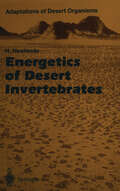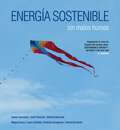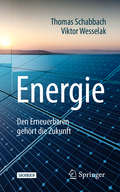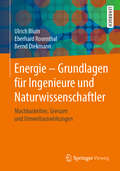- Table View
- List View
Energetic Particles in the Heliosphere (Astrophysics and Space Science Library #438)
by George M. SimnettThis monograph traces the development of our understanding of how and where energetic particles are accelerated in the heliosphere and how they may reach the Earth. Detailed data sets are presented which address these topics. The bulk of the observations are from spacecraft in or near the ecliptic plane. It is timely to present this subject now that Voyager-1 has entered the true interstellar medium. Since it seems unlikely that there will be a follow-on to the Voyager programme any time soon, the data we already have regarding the outer heliosphere are not going to be enhanced for at least 40 years.
Energetic Particles in Tokamak Plasmas
by Sergei SharapovThe study of energetic particles in magnetic fusion plasmas is key to the development of next-generation "burning" plasma fusion experiments, such as the International Thermonuclear Experimental Reactor (ITER) and the Demonstration Power Station (DEMO). This book provides a comprehensive introduction and analysis of the experimental data on how fast ions behave in fusion-grade plasmas, featuring the latest ground-breaking results from world-leading machines such as the Joint European Torus (JET) and the Mega Ampere Spherical Tokamak (MAST). It also details Alfvenic instabilities, driven by energetic ions, which can cause enhanced transport of energetic ions. MHD spectroscopy of plasma via observed Alfvenic waves called "Alfvén spectroscopy" is introduced and several applications are presented. This book will be of interest to graduate students, researchers, and academics studying fusion plasma physics. Features: Provides a comprehensive overview of the field in one cohesive text, with the main physics phenomena explained qualitatively first. Authored by an authority in the field, who draws on his extensive experience of working with energetic particles in tokamak plasmas. Is suitable for extrapolating energetic particle phenomena in fusion to other plasma types, such as solar and space plasmas.
Energetic Particles in Tokamak Plasmas
by Sergei SharapovThe study of energetic particles in magnetic fusion plasmas is key to the development of next-generation "burning" plasma fusion experiments, such as the International Thermonuclear Experimental Reactor (ITER) and the Demonstration Power Station (DEMO). This book provides a comprehensive introduction and analysis of the experimental data on how fast ions behave in fusion-grade plasmas, featuring the latest ground-breaking results from world-leading machines such as the Joint European Torus (JET) and the Mega Ampere Spherical Tokamak (MAST). It also details Alfvenic instabilities, driven by energetic ions, which can cause enhanced transport of energetic ions. MHD spectroscopy of plasma via observed Alfvenic waves called "Alfvén spectroscopy" is introduced and several applications are presented. This book will be of interest to graduate students, researchers, and academics studying fusion plasma physics. Features: Provides a comprehensive overview of the field in one cohesive text, with the main physics phenomena explained qualitatively first. Authored by an authority in the field, who draws on his extensive experience of working with energetic particles in tokamak plasmas. Is suitable for extrapolating energetic particle phenomena in fusion to other plasma types, such as solar and space plasmas.
Energetic Phenomena on the Sun (Astrophysics and Space Science Library #153)
by M. R. Kundu B. Woodgate E. J. SchmahlThis publication is a result of three meetings, each 5 days long, held at the Goddard Space Flight Center on January 24-28, 1983, June 8-14, 1983, and February 13-17, 1984. The meetings were held in the interim between the full operations of the Solar Maximum Mission (SMM) in 1980, and the renewed operations after its repair in orbit in April 1984. Their general objectives were as follows: o Synthesize flare studies after three years of SMM data analysis. Many analyses of individual flares and individual phenomena, often jointly across many data sources had been published, but a need existed for a broader synthesis and updating of our understanding of solar flares since the Skylab Flare Workshops held several years earlier. o Encourage a broader participation in the SMM data anlysis and combine this more fully with theory and other data sources--data obtained with other spacecraft such as the HINOTORI, P78-1, and ISEE-3 spacecrafts, and with the Very Large Array (VLA) and many other ground-based instruments. Many coordinated data sets, unprecedented in their breadth of coverage and multiplicity of sources, had been obtained within the structure of the Solar Maximum Year (SMY). o Stimulate joint studies, and publication in the general scientific literature. The intended primary benefit was for informal collaborations to be started or broadened at the Workshops with subsequent publications. o Provide a special publication resulting from this Workshop. o Provide a starting point of understanding for planning renewed full observations with the repaired SMM.
Energetic Relaxation to Structured Deformations: A Multiscale Geometrical Basis for Variational Problems in Continuum Mechanics (SpringerBriefs on PDEs and Data Science)
by José Matias Marco Morandotti David R. OwenThis book is the first organized collection of some results that have been obtained by the authors, their collaborators, and other researchers in the variational approach to structured deformations. It sets the basis and makes more accessible the theoretical apparatus for assigning an energy to a structured deformation, thereby providing motivation to researchers in applied mathematics, continuum mechanics, engineering, and materials science to study the deformation of a solid body without committing at the outset to a specific mechanical theory. Researchers will benefit from an approach in which elastic, plastic, and fracture phenomena can be treated in a unified way.The book is intended for an audience acquainted with measure theory, the theory of functions of bounded variation, and continuum mechanics. Any students in their last years of undergraduate studies, graduate students, and researchers with a background in applied mathematics, the calculus of variations, and continuum mechanics will have the prerequisite to read this book.
Energetics of Desert Invertebrates (Adaptations of Desert Organisms)
by Harold HeatwoleDesert invertebrates live in an environment where resources alternate unpredictably between brief periods of plenty and prolonged scarcity. This book describes the adaptive strategies of desert invertebrates in acquiring energy and sustaining life with such fluctuations. Some cooperate in foraging; others compete for resources. Some are nomadic and migrate to more favorable sites as conditions change. Others conserve energy by going into a deep dormancy until better conditions return. Still others store food during plentiful periods so as to retreat underground during less favorable times. The adaptive modes of economizing on scarce energy resources are diverse and lead to an appreciation of the intricate interactions of animals living close to their environmental limits.
The Energetics of Mangrove Forests
by Daniel AlongiDespite their importance in sustaining livelihoods for many people living along some of the world’s most populous coastlines, tropical mangrove forests are disappearing at an alarming rate. Occupying a crucial place between land and sea, these tidal ecosystems provide a valuable ecological and economic resource as important nursery grounds and breeding sites for many organisms, and as a renewable source of wood and traditional foods and medicines. Perhaps most importantly, they are accumulation sites for sediment, contaminants, carbon and nutrients, and offer significant protection against coastal erosion. This book presents a functional overview of mangrove forest ecosystems; how they live and grow at the edge of tropical seas, how they play a critical role along most of the world’s tropical coasts, and how their future might look in a world affected by climate change. Such a process-oriented approach is necessary in order to further understand the role of these dynamic forests in ecosystem function, and as a first step towards developing adequate strategies for their conservation and sustainable use and management. The book will provide a valuable resource for researchers in mangrove ecology as well as reference for resource managers.
Energetics of Organic Free Radicals (Structure Energetics and Reactivity in Chemistry Series #4)
by José A. Martinho Simões Joel F. Liebman A. GreenbergEnergetics of Organometallic Species (Nato Science Series C: #367)
by José A. Martinho SimõesAn overview of modern organometallic thermochemistry, made by some of the most active scientists in the area, is offered in this book. The contents correspond to the seventeen lectures delivered at the NATO ASI Energetics of Organometallic Species (Curia, Portugal, September 1991), plus three other invited contributions from participants of that summer school. These papers reflect a variety of research interests, and discuss results obtained with several techniques. It is therefore considered appropriate to add a few preliminary words, attempting to bring some unity out of that diversity. In the first three chapters, results obtained by classical calorimetric methods are described. Modern organometallic thermochemistry started in Manchester, with Henry Skinner, and his pioneering work is briefly surveyed in the first chapter. The historical perspective is followed by a discussion of a very actual issue: the trends of stepwise bond dissociation enthalpies. Geoff Pilcher, another Manchester thermochemist, makes, in chapter 2, a comprehensive and authoritative survey of problems found in the most classical of thermochemical techniques - combustion calorimetr- applied to organometallic compounds. Finally, results from another classical technique, reaction-solution calorimetry, are reviewed in the third chapter, by Tobin Marks and coworkers. More than anybody else, Tobin Marks has used thermochemical values to define synthetic strategies for organometallic compounds, thus indicating an application of thermochemical data of which too little use has been made so far.
Energetics of Secretion Responses: Volume II (CRC Press Revivals)
by J. W. N. AkkermanProvides a multidisciplinary approach to the study of energetics of secretion responses by combining the knowledge and expertise of leading authorities from various fields.
Energetics of Secretion Responses: Volume I (CRC Press Revivals)
by J.W.N. AkkermanProvides a multidisciplinary approach to the study of energetics of secretion responses by combining the knowledge and expertise of leading authorities from various fields.
Energetics of Secretion Responses: Volume I (CRC Press Revivals)
by J.W.N. AkkermanProvides a multidisciplinary approach to the study of energetics of secretion responses by combining the knowledge and expertise of leading authorities from various fields.
Energetics of Secretion Responses: Volume II (CRC Press Revivals)
by Jan-Willem N. AkkermanProvides a multidisciplinary approach to the study of energetics of secretion responses by combining the knowledge and expertise of leading authorities from various fields.
Energetics of Stable Molecules and Reactive Intermediates (Nato Science Series C: #535)
by M. E. Minas Da PiedadeCovers the major experimental and theoretical methods currently used to study the energetics of stable molecules and reactive intermediates. Reviews the ate of the art and shows the interplay of experimental and theoretical methods used to probe bonding energetics and reactivity and a wide range of chemical species. A modern and invaluable introduction to the study of molecular energetics. A reference for workers currently involved in the field.
Energía sostenible sin malos humos (without the hot air)
by Javier Samanes Pascual Julio Pascual Miqueleiz Alberto Berrueta Irigoyen Miguel Araiz Vega Leyre Catalán Ros Patricia Aranguren Garacochea David Arricibita AndrésLa edición en rústica de este libro está editada por la UPNA - Universidad Pública de Navarra. Las ediciones de libros electrónicos son distribuidas por UIT y están disponibles sin costo alguno en los minoristas habituales de libros electrónicos en línea.El recurso renovable es «enorme», pero nuestro consumo también es «enorme». Para comparar cosas «enormes» necesitamos números, no adjetivos. Este libro acaba con todas las afirmaciones contradictorias de la prensa, gobiernos y grupos de presión sea cual sea su ideología. Te ofrece los números y hechos que necesitas, en porciones fáciles de digerir, para que puedas entender el problema y construir tus propias conclusiones. Este libro ha sido escrito por un grupo de siete profesores e investigadores de la Universidad Pública de Navarra, de las áreas de ingeniería eléctrica y térmica, unidos por las energías renovables.
Energía sostenible sin malos humos (without the hot air #7)
by Javier Samanes Pascual Julio Pascual Miqueleiz Alberto Berrueta Irigoyen Miguel Araiz Vega Leyre Catalán Ros Patricia Aranguren Garacochea David Arricibita AndrésLa edición en rústica de este libro está editada por la UPNA - Universidad Pública de Navarra. Las ediciones de libros electrónicos son distribuidas por UIT y están disponibles sin costo alguno en los minoristas habituales de libros electrónicos en línea.El recurso renovable es «enorme», pero nuestro consumo también es «enorme». Para comparar cosas «enormes» necesitamos números, no adjetivos. Este libro acaba con todas las afirmaciones contradictorias de la prensa, gobiernos y grupos de presión sea cual sea su ideología. Te ofrece los números y hechos que necesitas, en porciones fáciles de digerir, para que puedas entender el problema y construir tus propias conclusiones. Este libro ha sido escrito por un grupo de siete profesores e investigadores de la Universidad Pública de Navarra, de las áreas de ingeniería eléctrica y térmica, unidos por las energías renovables.
Energie: Physikalische Grundlagen ihrer Erzeugung, Umwandlung und Nutzung (Teubner Studienbücher Physik)
by Bernd Diekmann Klaus HeinlothIn dem vorliegenden Band wird naturwissenschaftlich-physikalische Hintergrundinformation zum Thema Energie bereitgestellt, um dem Leser objektive Bewertungskriterien für die global hochaktuelle Diskussion der Zukunft unserer Energieversorgung an die Hand zu geben.
Energie: Physikalische Grundlagen ihrer Erzeugung, Umwandlung und Nutzung
by Bernd Diekmann Eberhard RosenthalIn dem vorliegenden Band wird naturwissenschaftlich-physikalische Hintergrundinformation zum Thema Energie bereitgestellt, um dem Leser objektive Bewertungskriterien für die global hochaktuelle Diskussion der Zukunft unserer Energieversorgung an die Hand zu geben. Insbesondere ist es ein zentrales Anliegen, dem Leser eine Bilanzierung aller Quellen hinsichtlich der Einflussnahme ihrer Gewinnung und Verwendung auf die Umwelt zu erstellen und das jeweilige Risiko zueinander in Relation zu setzen. Nach Festlegung des Begriffes Energie und ihrer Erscheinungsformen werden globale Randbedingungen des Umgangs mit Energie aufgezeigt. Diese Randbedingungen werden sodann für Deutschland als typischem Industrieland enger eingegrenzt. Die Palette infrage kommender Quellen, fossile, erneuerbare und nukleare, wird sodann im Detail vorgestellt. Ergiebigkeit der Ressourcen sowie sonstige Möglichkeiten und Grenzen des Einsatzes werden diskutiert; alle Energiequellen werden sodann nach Definition eines energetischen Erntefaktors miteinander verglichen. Die Speicher- und Transportmöglichkeiten und - hiermit eng verbunden - die Handlungsspielräume rationellen Umgangs mit den diversen Formen der Energie bilden einen weiteren Schwerpunkt. Der an naturwissenschaftlicher Hintergrundinformation interessierte Leser findet in einem gesonderten Kapitel eine detaillierte Präsentierung ausgewählter Techniken.
Energie: Richtig bewerten und sinnvoll nutzen (essentials)
by Heinz HerwigHeinz Herwig vermittelt eine klare Vorstellung davon, was Energie aus physikalischer Sicht ist und in welchen Formen sie auftreten kann. Es werden grundlegende mechanische, vor allem aber auch thermodynamische Zusammenhänge erläutert, bevor an konkreten Beispielen (Wärmeübergang, GuD-Kraftwerke, Wärmepumpen) gezeigt wird, wie mit Energie verantwortlich umgegangen werden kann, wie Energie richtig bewertet und sinnvoll genutzt werden sollte. Im Zuge dieser Erläuterungen wird der Exergie-Begriff eingeführt und ausführlich behandelt. Mit diesem Begriff kann die Qualität von Energie sehr anschaulich dargestellt werden.
Energie: Den Erneuerbaren gehört die Zukunft (Technik im Fokus)
by Thomas Schabbach Viktor WesselakUnser heutiges Energiesystem befindet sich in der Krise: Der wachsende Verbrauch natürlicher Ressourcen stößt an seine objektive Grenze. In dieser kompakten Darstellung werden die technischen, ökologischen und gesellschaftlichen Herausforderungen an ein zukunftsfähiges Energiesystem herausgearbeitet und gut lesbar vermittelt. Mit diesem Band aus der Reihe „Technik im Fokus“ finden Leser einen leichten Einstieg in die Thematik, eine tiefgehendere Diskussion von System- und auch Technologiefragen bieten weitere Bände derselben Reihe.
Energie: Die Zukunft wird erneuerbar (Technik im Fokus)
by Thomas Schabbach Viktor WesselakUnser heutiges Energiesystem befindet sich in der Krise: Der wachsende Verbrauch natürlicher Ressourcen stößt an seine objektive Grenze. In dieser kompakten Darstellung werden die technischen, ökologischen und gesellschaftlichen Herausforderungen an ein zukunftsfähiges Energiesystem herausgearbeitet und gut lesbar vermittelt. Mit diesem Band aus der Reihe „Technik im Fokus“ finden Leser einen leichten Einstieg in die Thematik, eine tiefgehendere Diskussion von System- und auch Technologiefragen bieten weitere Bände derselben Reihe.
Energie – Grundlagen für Ingenieure und Naturwissenschaftler: Machbarkeiten, Grenzen und Umweltauswirkungen
by Ulrich Blum Eberhard Rosenthal Bernd DiekmannDie Grundlagen der Energietechnik erklärt von Physikern für Nicht-Physiker.Didaktisch aufbereitet präsentieren die Autoren des Buches die allgemeinen Grundlagen sowie die Erklärungen zu den wichtigsten Technologien zur Versorgung mit elektrischer Energie. Die Risiken aus der Wandlung zu elektrischer Energie und die möglichen Umweltbelastungen werden aus Sicht naturgesetzlicher Gegebenheiten analysiert und diskutiert.
Energie – Wie verschwendet man etwas, das nicht weniger werden kann?
by Martin BuchholzSie lesen täglich etwas über Energieproduktion, Energiewende, erneuerbare Energien und Energieverschwendung - aber wissen Sie überhaupt, was genau das eigentlich ist - Energie? In diesem Buch erklärt Martin Buchholz gut verständlich und in lockerem Stil diesen ganz grundlegenden Begriff der Thermodynamik.Dieses Buch zeigt auf, welche Missverständnisse in unseren Köpfen existieren. Es richtet sich somit an alle, die nie richtig verstanden haben, warum man Wärme und Strom zwar beide in Kilowattstunden messen kann, aber Wärme trotzdem weniger wert ist. Warum noch niemand ein Perpetuum mobile erfunden hat. Was eigentlich die Entropie mit allem zu tun hat. Und warum man „Energie sparen“ soll, obwohl es doch eine Größe ist, die laut Physikbuch nicht mehr und nicht weniger werden kann. Außerdem spricht es die an, die bei der Diskussion über Herausforderungen der Energiewende und der Angst vor einem Black-Out mitreden wollen.
Energie – Wie verschwendet man etwas, das nicht weniger werden kann?
by Martin BuchholzSie lesen täglich etwas über Energieproduktion, Energiewende, erneuerbare Energien und Energieverschwendung - aber wissen Sie überhaupt, was genau das eigentlich ist - Energie? In diesem Buch erklärt Martin Buchholz gut verständlich und in lockerem Stil diesen ganz grundlegenden Begriff der Thermodynamik.Dieses Buch ist für alle, die über vermeintlich hohe Stromrechnungen und die Probleme der Energiewende mitreden wollen. Es zeigt auf, welche Missverständnisse in unseren Köpfen existieren und warum es sich lohnt, „Energie“ als Ganzes zu begreifen. Es richtet sich an alle, die nie richtig verstanden haben, warum man Wärme und Strom zwar beide in Kilowattstunden messen kann, aber Wärme trotzdem weniger wert ist. Warum noch niemand ein Perpetuum mobile erfunden hat. Was eigentlich die Entropie mit allem zu tun hat. Und warum man „Energie sparen“ soll, obwohl es doch eine Größe ist, die laut Physikbuch nicht mehr und nicht weniger werden kann.
Energie aus Biomasse: — eine Chance für die Landwirtschaft (Veröffentlichungen der Akademie für Technikfolgenabschätzung in Baden-Württemberg)
by Holger Flaig Hans MohrAls Alternative zu fossilen Brennstoffen stellt das Buch die Verwendung pflanzlicher Biomasse als erneuerbare und weitgehend CO2-neutrale Energiequelle vor: Treibstoff aus Rapsöl, Festbrennstoffe aus Reststoffen (Holz, Stroh), speziell angebaute Energiepflanzen zur direkten thermischen Nutzung. Die Empfehlungen sind klar und wissenschaftlich begründet.




















